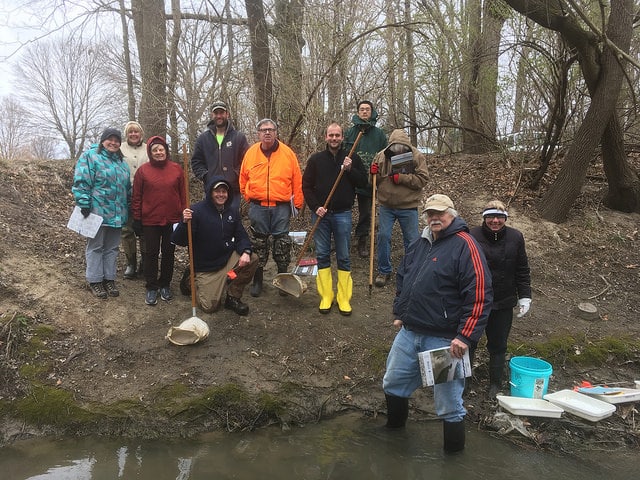By Andrew Rehn
Last Saturday, RiverWatch trainer Matt Young and five brave river citizens (including myself), wearing questionably waterproof boots, waded into the chilly March waters of the Saline Branch in Urbana’s Crystal Lake Park. Another six participants without waterproof gear watched from the riverbank. We were participating in a RiverWatch training session, becoming citizen scientists ready to observe and report on the water quality of Illinois’ rivers.

RiverWatch is a statewide organization run out of the National Great Rivers Research and Education Center in Alton, Illinois. Volunteers for RiverWatch monitor the aquatic habitat of small streams at over 100 sites across the state. Matt then collects and analyzes the data, making it available to the public. Check out the cool map they have to see if a stream near you is being RiverWatched.
The training for RiverWatch was an engaging all-day experience. In the morning, we learned how to identify the various kinds of macroinvertebrates that we might find in the river. Macroinvertebrates indicate river health. Much like the canary in the coal mine, these little bugs tell you how the river is doing. Some of these critters, like the Saddle Case Caddisfly, are remarkably sensitive to water pollution. If you can find the Saddle Case Caddisfly in your stream, you know it’s a healthy waterway! On the other hand, the unpleasant sounding bloodworms can handle all kinds of pollution, and if all you can find are bloodworms, it means that the stream is heavily polluted.
In the afternoon, we assessed a 200ft portion of the Saline Branch for canopy cover, riverbed composition, vegetation, and more. Once we had thoroughly characterized our chosen site, we proceeded to hunt the buggies! Our chosen river section contained a riffle, prime habitat for macro-invertebrates of all kinds. We turned over a small section of rock and stirred up the riverbed for exactly 3 minutes (the process is quite scientific) to dislodge bugs into our net just downstream. We then identified the creatures we captured.
Good news for the Saline Branch, we were able to find a wide diversity of species, even some fairly sensitive ones. Many of these bugs aren’t fully populated until May. Seeing so many in March is a good sign.
I had a great time, despite the cold, and am looking forward to picking a stream to monitor in May, when the water will be warm and the sun will be shining!
It’s not too late to get involved. RiverWatch is hosting additional training sessions in the next few weeks, including in Alton, Carbondale, and Mahomet. Check out their calendar below for a full list of events. If you can’t make a training session, you can still participate. Each site needs to have at least one trained volunteer when being assessed, but any number of untrained volunteers can join as well. You can find a list of monitored sites looking for volunteers here, and if you are in the Champaign Urbana area, you can contact me about other sites that may be starting up around town.
STAFF CONTACTS:
- Andrew Rehn, Water Resources Engineer, arehn @ prairierivers.org







